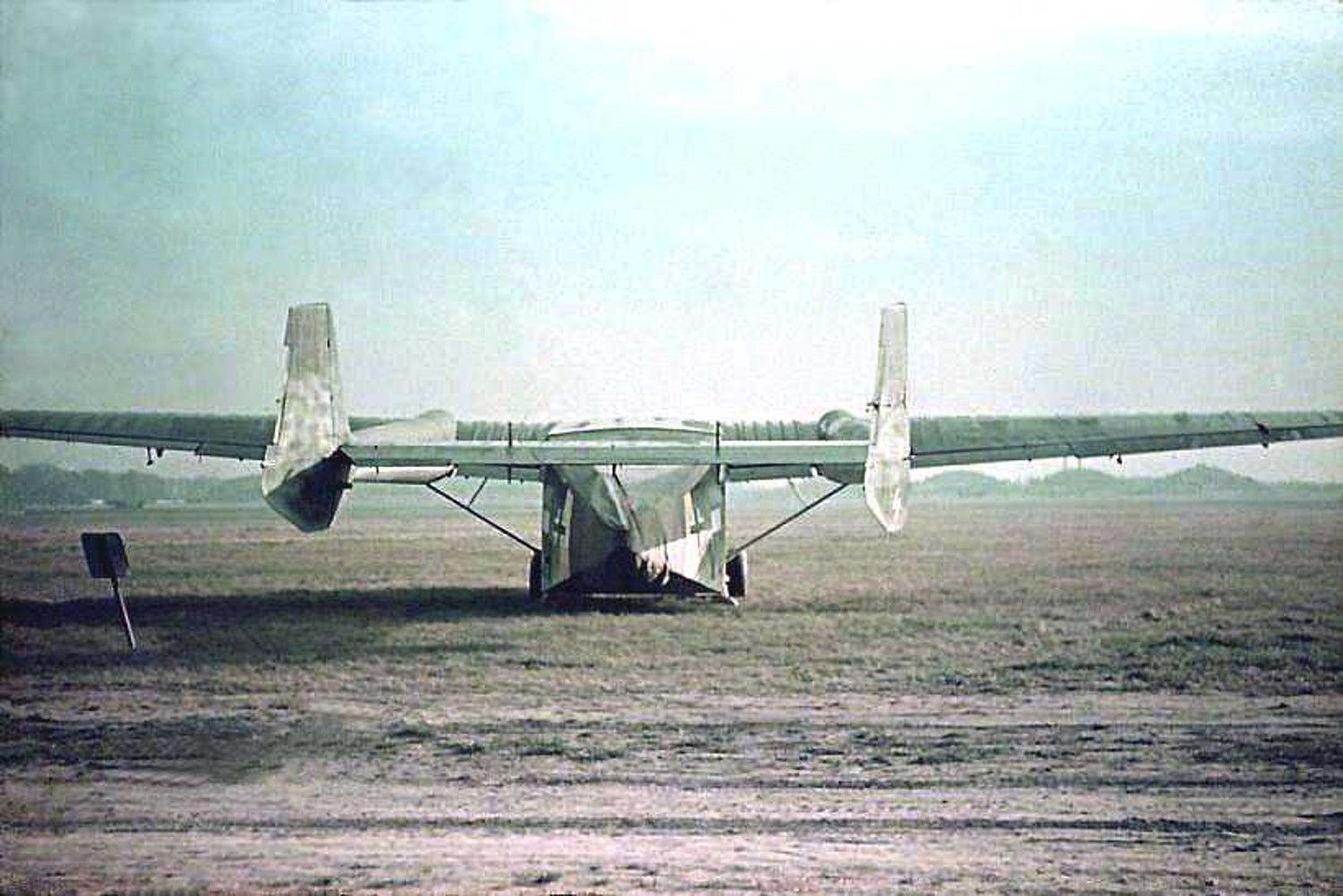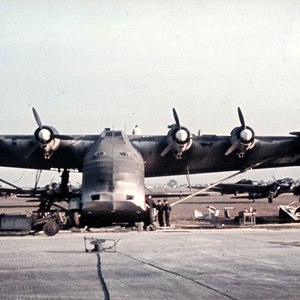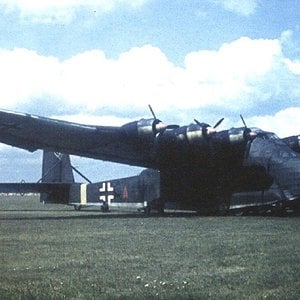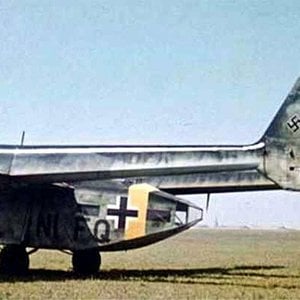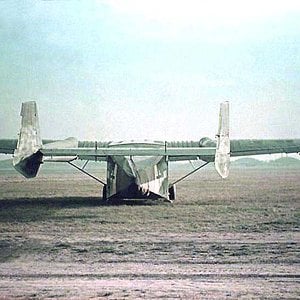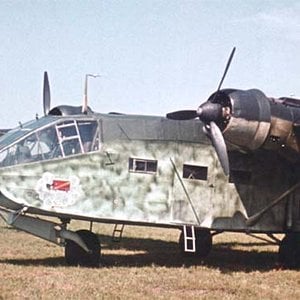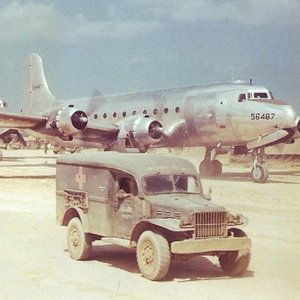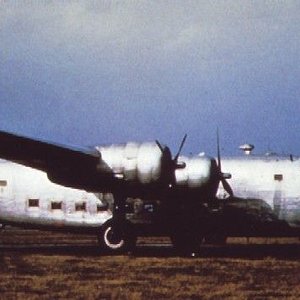Navigation
Install the app
How to install the app on iOS
Follow along with the video below to see how to install our site as a web app on your home screen.
Note: This feature may not be available in some browsers.
More options
You are using an out of date browser. It may not display this or other websites correctly.
You should upgrade or use an alternative browser.
You should upgrade or use an alternative browser.
Development
The Go 244 was the powered version of the Gotha Go 242 military glider transport. Studies for powered versions of the Go 242 began early in the design of the glider, with one early proposal being for modification to allow a single Argus As 10C engine to be temporarily attached to the nose of the glider to allow recovery back to base after use. This idea was rejected, but the alternative of a permanently powered twin-engined version was taken forward.[1]
Three Go 242s were modified as prototypes of the powered Go 244, fitted with varying surplus radial engines. The first prototype, the Go 244 V1 was powered by two 660 hp (492 kW) BMW 132, while the second prototype had 700 hp (522 kW) Gnome-Rhône 14Ms and the third 750 hp (560 kW) Shvetsov M-25A engines. Although only the third prototype offered adequate engine out performance, the Luftwaffe had large stocks of captured Gnome engines, so this was chosen as the basis for the production conversion, although a few more aircraft were fitted with the BMW and Shvetsov engines.[2][3]
The B series was the main production model, being based on the Go 242B with a wheeled tricycle undercarriage and with fuel and oil carried in the tailbooms.[4] 133 were converted from Go 242 Bs, while a further 41 were built from new before production reverted to the glider Go 242.[5] Plans were also created for single-engined variants with a nose-mounted Argus A 10C or Junkers Jumo 211.[6]
[edit] Operational history
The first examples of the Go 244 were delivered to operational units in Greece and Crete in March 1942. Some were also assigned to transport Geschwader in North Africa and the Eastern Front but on the former front they proved vulnerable to anti-aircraft fire and were withdrawn, being replaced by Junkers Ju 52 or Messerschmitt Me 323 aircraft.[6]
[edit] Variants
Go 244 A-1 - prototype, using the BMW 132 radial engine
Go 244 B-1 - production version, with fixed landing gear
Go 244 B-2 - B-1 with improved landing gear including a larger semi-retractable nose wheel
Go 242 B-3 - paratroop-carrying version of B-1 with double rear doors
Go 244 B-4 - paratroop-carrying version of B-2 with doors of B-3 and landing gear of B-2
Go 244 B-5 - training version with dual controls
[edit] Specifications (Go 244 B-1)
Data from Gotha's Twin-Boom Troopers[7]
General characteristics
Crew: 1 or 2 pilots
Capacity: up to 23 troops or freight
Length: 15.80 m (51 ft 10 in)
Wingspan: 24.50 m (80 ft 4½ in)
Height: 4.70 m (15 ft 5 in)
Wing area: 64.4 m² (693 ft²)
Empty weight: 5,100 kg (11,243 lb)
Loaded weight: 6,800 kg (14,991 lb)
Max takeoff weight: 7,162 kg (15,789 lb)
Powerplant: 2 × Gnome-Rhône 14M 06/07 14-cylinder radial engine, 742 hp (553 kW) at 2,000 m (6,560 ft) each
Performance
Maximum speed: 290 km/h (157 knots, 180 mph) at 4,000 m (13,100 ft)
Cruise speed: 270 km/h (146 knots, 168 mph) at 3,900 m (12,800 ft)
Range: 410 km (222 nmi, 255 mi)
Service ceiling: 8,350 m (27,395 ft)
Climb to 1,000 m (3,300 ft): 3 min
Armament
Guns: 3 × 7.92 mm (.312 in) MG 15 or MG 81Z machine guns
The Go 244 was the powered version of the Gotha Go 242 military glider transport. Studies for powered versions of the Go 242 began early in the design of the glider, with one early proposal being for modification to allow a single Argus As 10C engine to be temporarily attached to the nose of the glider to allow recovery back to base after use. This idea was rejected, but the alternative of a permanently powered twin-engined version was taken forward.[1]
Three Go 242s were modified as prototypes of the powered Go 244, fitted with varying surplus radial engines. The first prototype, the Go 244 V1 was powered by two 660 hp (492 kW) BMW 132, while the second prototype had 700 hp (522 kW) Gnome-Rhône 14Ms and the third 750 hp (560 kW) Shvetsov M-25A engines. Although only the third prototype offered adequate engine out performance, the Luftwaffe had large stocks of captured Gnome engines, so this was chosen as the basis for the production conversion, although a few more aircraft were fitted with the BMW and Shvetsov engines.[2][3]
The B series was the main production model, being based on the Go 242B with a wheeled tricycle undercarriage and with fuel and oil carried in the tailbooms.[4] 133 were converted from Go 242 Bs, while a further 41 were built from new before production reverted to the glider Go 242.[5] Plans were also created for single-engined variants with a nose-mounted Argus A 10C or Junkers Jumo 211.[6]
[edit] Operational history
The first examples of the Go 244 were delivered to operational units in Greece and Crete in March 1942. Some were also assigned to transport Geschwader in North Africa and the Eastern Front but on the former front they proved vulnerable to anti-aircraft fire and were withdrawn, being replaced by Junkers Ju 52 or Messerschmitt Me 323 aircraft.[6]
[edit] Variants
Go 244 A-1 - prototype, using the BMW 132 radial engine
Go 244 B-1 - production version, with fixed landing gear
Go 244 B-2 - B-1 with improved landing gear including a larger semi-retractable nose wheel
Go 242 B-3 - paratroop-carrying version of B-1 with double rear doors
Go 244 B-4 - paratroop-carrying version of B-2 with doors of B-3 and landing gear of B-2
Go 244 B-5 - training version with dual controls
[edit] Specifications (Go 244 B-1)
Data from Gotha's Twin-Boom Troopers[7]
General characteristics
Crew: 1 or 2 pilots
Capacity: up to 23 troops or freight
Length: 15.80 m (51 ft 10 in)
Wingspan: 24.50 m (80 ft 4½ in)
Height: 4.70 m (15 ft 5 in)
Wing area: 64.4 m² (693 ft²)
Empty weight: 5,100 kg (11,243 lb)
Loaded weight: 6,800 kg (14,991 lb)
Max takeoff weight: 7,162 kg (15,789 lb)
Powerplant: 2 × Gnome-Rhône 14M 06/07 14-cylinder radial engine, 742 hp (553 kW) at 2,000 m (6,560 ft) each
Performance
Maximum speed: 290 km/h (157 knots, 180 mph) at 4,000 m (13,100 ft)
Cruise speed: 270 km/h (146 knots, 168 mph) at 3,900 m (12,800 ft)
Range: 410 km (222 nmi, 255 mi)
Service ceiling: 8,350 m (27,395 ft)
Climb to 1,000 m (3,300 ft): 3 min
Armament
Guns: 3 × 7.92 mm (.312 in) MG 15 or MG 81Z machine guns

